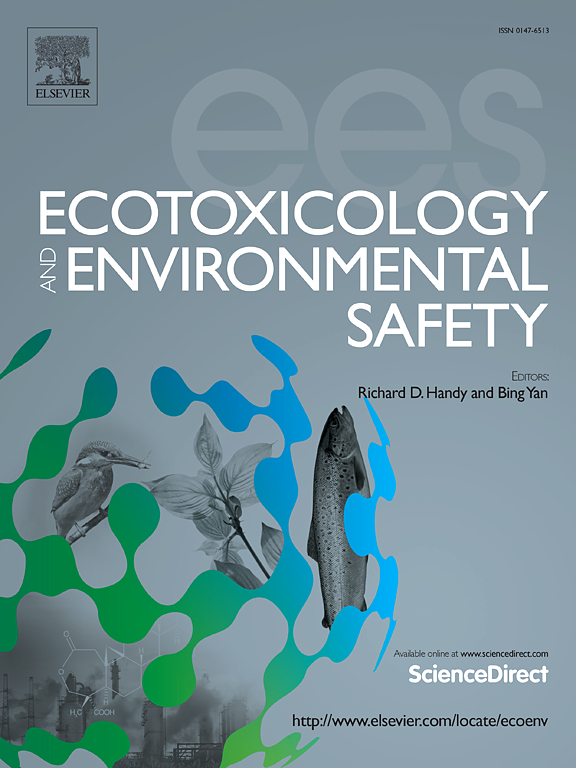网络毒理学和单细胞测序揭示了多溴联苯醚银屑病毒性的潜在机制
IF 6.2
2区 环境科学与生态学
Q1 ENVIRONMENTAL SCIENCES
引用次数: 0
摘要
多溴联苯醚(PBDEs)是一种主要的溴化阻燃剂,由于其环境持久性和生物蓄积性,已涉及各种健康问题。多溴二苯醚由于其低疏水性而优先积聚在皮肤中,并可能导致牛皮癣的发作。在这项研究中,我们旨在通过单细胞分辨率的网络毒理学研究pbde诱导银屑病毒性的潜在机制。首先,确定了多溴二苯醚和牛皮癣之间的139个重叠靶点,并绘制了它们的蛋白-蛋白相互作用(PPIs)图谱。富集分析表明,多溴二苯醚靶向基因可能通过过度活跃的免疫反应加重银屑病病变。单细胞测序显示,在PBDE富集的情况下,主要通过IL-24信号通路进行全面的免疫细胞激活。此外,分子对接分析显示,PBDEs与HSP90AA1、MAPK3、MMP9、TP53和CASP3等枢纽靶点具有特异性结合作用,这些靶点在银屑病发病机制中起着至关重要的作用。总之,我们的发现为理解多溴二苯醚诱发皮肤毒性的潜在分子机制奠定了坚实的理论基础。将网络毒理学与单细胞测序相结合,可以提高污染物暴露在致病机制中的预测准确性。本研究提出了一种跨学科的策略,具有未开发的潜力,可以减轻污染物暴露,从而有助于预防和治疗相关疾病。本文章由计算机程序翻译,如有差异,请以英文原文为准。
Network toxicological and single-cell sequencing reveals the potential mechanisms of psoriatic toxicity of polybrominated diphenyl ethers
Polybrominated diphenyl ethers (PBDEs), major brominated flame retardants, have been implicated in various health issues due to their environmental persistence and bioaccumulation. PBDEs preferentially accumulate in the skin due to their low hydrophobicity and may contribute to the onset of psoriasis. In this study, we aimed to investigate the potential mechanisms of PBDE-induced psoriatic toxicity by utilizing network toxicology at single-cell resolution. Initially, 139 overlapping targets between PBDEs and psoriasis were identified, and their protein-protein interactions (PPIs) were mapped. Enrichment analysis indicated that PBDEs-targeted genes might worsen psoriatic lesions through an overactive immune response. Single-cell sequencing revealed a comprehensive immune cell activation, predominantly through the IL-24 signaling pathway, in response to PBDE enrichment. Moreover, the molecular docking analysis revealed that PBDEs exhibited specific binding interactions with hub targets such as HSP90AA1, MAPK3, MMP9, TP53, and CASP3, which are crucial for psoriasis pathogenesis. In conclusion, our findings establish a solid theoretical basis for understanding the potential molecular mechanisms underlying PBDE-induced cutaneous toxicity. Integrating network toxicology with single-cell sequencing refines the prediction accuracy of pollutant exposure across pathogenic mechanisms. This study presents an interdisciplinary strategy with untapped potential for mitigating pollutant exposure, thereby aiding in the prevention and treatment of related diseases.
求助全文
通过发布文献求助,成功后即可免费获取论文全文。
去求助
来源期刊
CiteScore
12.10
自引率
5.90%
发文量
1234
审稿时长
88 days
期刊介绍:
Ecotoxicology and Environmental Safety is a multi-disciplinary journal that focuses on understanding the exposure and effects of environmental contamination on organisms including human health. The scope of the journal covers three main themes. The topics within these themes, indicated below, include (but are not limited to) the following: Ecotoxicology、Environmental Chemistry、Environmental Safety etc.

 求助内容:
求助内容: 应助结果提醒方式:
应助结果提醒方式:


